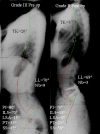Spino-pelvic alignment after surgical correction for developmental spondylolisthesis
- PMID: 18600350
- PMCID: PMC2527424
- DOI: 10.1007/s00586-008-0713-y
Spino-pelvic alignment after surgical correction for developmental spondylolisthesis
Abstract
This study is a retrospective multi-centre analysis of changes in spino-pelvic sagittal alignment after surgical correction of L5-S1 developmental spondylolisthesis. The purpose of this study was to determine how sagittal spino-pelvic alignment is affected by surgery, with the hypothesis that surgical correction at the lumbo-sacral level is associated with an improvement in the shape of the spine and in the orientation of the pelvis. Whether L5-S1 high grade spondylolisthesis should or should not be reduced remains a controversial subject. A popular method of treatment has been in situ fusion, but studies have reported a high rate of pseudarthrosis, slip progression and persistent cosmetic deformity. Spinal instrumentation with pedicle screws has generated a renewed interest for reduction, but the indications for this treatment and its effect on spino-pelvic alignment remain poorly defined. Recent evidence indicates that reduction might be indicated for subjects with an unbalanced (retroverted or vertical) pelvis. This is a retrospective multi-centre analysis of 73 subjects (mean age 18 +/- 3 years) with developmental spondylolisthesis and an average follow-up of 1.9 years after reduction and posterior fusion with spinal instrumentation or cast immobilisation. Spinal and pelvic alignment were measured on standing lateral digitised X-rays using a computer software allowing a very high inter and intra observer reliability. Pelvic incidence was unaffected by surgery. The most important changes were noted for grade, L5 Incidence, lumbo-sacral-angle, and lumbar lordosis, which all decreased significantly towards normal adult values. At first evaluation, pelvic tilt, sacral slope and thoracic kyphosis appeared minimally affected by surgery. However, after classifying subjects into balanced and unbalanced pelvis, significant improvements were noted in pelvic alignment in both the sub-groups, with 40% of cases switching groups, the majority from an unbalanced to a balanced pelvis alignment. The direction and magnitude of these changes were significantly different by sub-group: sacral slope decreased in the balanced pelvis group but increased in the unbalanced group, while pelvic tilt values did the opposite. While pelvic shape is unaffected by attempts at surgical reduction, proper repositioning of L5 over S1 significantly improves pelvic balance and lumbar shape by decreasing the abnormally high lumbar lordosis and abnormal pelvic retroversion. These results emphasise the importance of sub-dividing subjects with high grade developmental spondylolisthesis into unbalanced and balanced pelvis groups, and further support the contention that reduction techniques might be considered for the unbalanced retroverted pelvis sub-group.
Figures



References
-
- Berthonnaud E, Roussouly P, Dimnet J. The parameters describing the shape and the equilibrium of the set back pelvis and femurs in sagittal view. Innov Tech Biol Med. 1998;19(6):411–426.
-
- Bradford DS, Gotfried Y. Staged salvage reconstruction of grade IV and grade V spondylolisthesis. J Bone Joint Surg (A) 1987;69:191–202. - PubMed
-
- Descamps H, Commare-Nordmann MC, Marty C, et al. Modification of pelvic angle during the human growth (in French) Biom Hum Anthropol. 2001;17:59–63.
Publication types
MeSH terms
LinkOut - more resources
Full Text Sources
Miscellaneous

